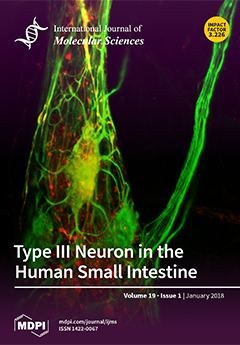The dysregulation of the ubiquitously transcribed TPR gene on the X chromosome (
UTX) has been reported to be involved in the oncogenesis of several types of cancers. However, the expression and significance of
UTX in esophageal squamous cell carcinoma (ESCC) remains
[...] Read more.
The dysregulation of the ubiquitously transcribed TPR gene on the X chromosome (
UTX) has been reported to be involved in the oncogenesis of several types of cancers. However, the expression and significance of
UTX in esophageal squamous cell carcinoma (ESCC) remains largely undetermined. Immunohistochemistry was performed in 106 ESCC patients, and correlated with clinicopathological features and survival. The functional role of
UTX in ESCC cells was determined by
UTX-mediated siRNA. Univariate analyses showed that high
UTX expression was associated with superior overall survival (OS,
p = 0.011) and disease-free survival (DFS,
p = 0.01).
UTX overexpression was an independent prognosticator in multivariate analysis for OS (
p = 0.013, hazard ratio = 1.996) and DFS (
p = 0.009, hazard ratio = 1.972). The 5-year OS rates were 39% and 61% in patients with low expression and high expression of
UTX, respectively. Inhibition of endogenous
UTX in ESCC cells increased cell viability and BrdU incorporation, and decreased the expression of epithelial marker E-cadherin. Immunohistochemically,
UTX expression was also positively correlated with E-cadherin expression. High
UTX expression is independently associated with a better prognosis in patients with ESCC and downregulation of
UTX increases ESCC cell growth and decreases E-cadherin expression. Our results suggest that
UTX may be a novel therapeutic target for patients with ESCC.
Full article






